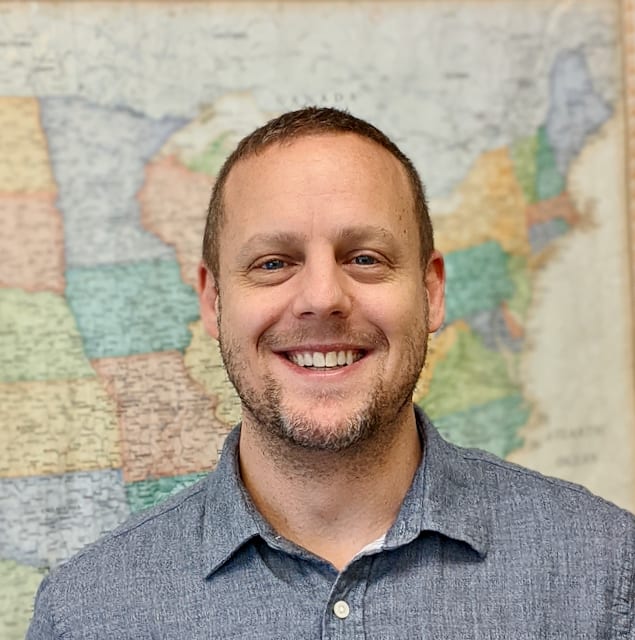Meet Our Teachers
Tyler Nice

Why might teachers seeking a Masters’ degree in history and government take time for a course using not only primary documents, but also imaginative literature?
Tyler Nice enrolled in a History/Literature seminar on Immigration because he wanted to challenge himself. Having taught Advanced Placement US History for ten years at Thurston High School (just east of Eugene, Oregon) he felt well-grounded in most aspects of our nation’s history—except immigration.
He knew he would learn a lot from the history professor co-teaching the course, Dan Monroe of Milliken University. Nice had appreciated Monroe’s candor and clarity in the core course on Sectionalism and Civil War. “In the first session of that class, Monroe said, ‘The primary cause of the Civil War was slavery.’ I thought, ‘I like you already.’ I appreciated that he wanted to give us a definitive historical answer” to a question often muddled by historiography.
Literature Deepens Historical Insights
 However, reading literature would take Nice outside his comfort zone. “I’m a huge reader of nonfiction, but I really don’t enjoy reading fiction that much. Still, I felt it would be a good challenge to try to do it.
However, reading literature would take Nice outside his comfort zone. “I’m a huge reader of nonfiction, but I really don’t enjoy reading fiction that much. Still, I felt it would be a good challenge to try to do it.
“I’m so glad I did! It was a wonderful course,” he said. Reading the text of legislation helped Nice grasp the changes in immigration policy during the 19th and 20th centuries. Reading first-person narratives from immigrants themselves helped him understand “the impact of these laws on people’s lives.” Reading fiction and poetry written by and about immigrants deepened this understanding.
“Other classes in the MAHG program give us short first-person narratives, but this class gave us entire short stories and even novels. For example, in a course on The Rise of Modern America, 1914-1945, we read a first-person account of a German American being harassed during World War I. That was illuminating—but it’s just two pages.” In the history/literature course, teachers read long portions of Willa Cather’s My Antonia, experiencing the homesickness of a Bohemian American musician transplanted from an old European city to a farm on the plains of Nebraska. They explored the cultural misunderstandings complicating friendship between the Bohemian man’s family and his native-born neighbors. “The medium of fiction gives authors the freedom to express complex ideas through symbols and other creative language,” Nice noted.
Fiction Speaks Through Symbolic Language
He traced such symbols through a memoir he found “kind of bizarre”: Maxine Hong Kingston’s The Woman Warrior. Kingston creatively reproduces her childhood psyche, caught between American culture and her mother’s vivid memories of the home country. The heroic story of her mother as a medical student in China gives way to the family’s current reality as owners of a San Francisco dry-cleaning business. Kingston renders her mother’s versions of family history and folklore in strange, even “grotesque” images. This “left me with a lot of questions,” which Nice worked through in class discussions with Professor Suzanne Brown. He enjoyed not only Brown’s “ability to pull nuance out of literary texts” but also her enthusiasm. When class participants noticed an image pattern resonating with symbolism, Brown “was so excited!”—which fed the teachers’ excitement. Nice remembers the page of the novel “where we realized what the main character’s mother means when she refers to ‘ghosts.’ They are non-Chinese Americans,” people whom the mother regards as insubstantial in their customs, yet menacing in their watchfulness. Speaking of the traditional Chinese food she prepares—delicacies to her, unappetizing oddities to white Americans—the mother boasts she “can defeat the ghosts: she can out-eat them,” Nice said.
More Than a Vocabulary Term
One story assigned for the course, Sui Sin Far’s “In the Land of the Free,” strongly impressed Nice. In it, a Chinese woman is returning to late 19th century San Francisco, where her husband is a businessman. She is bringing their son, whom she gave birth to while visiting her family in China. When the boat docks, American officials will not let them disembark, because the mother lacks immigration papers for her child. She is persuaded to leave the toddler with immigration officials until the papers can be obtained. This process takes ten months and requires the services of an expensive attorney. Finally, the mother goes to retrieve her son from the convent where he has been kept. The little boy no longer recognizes her.
Nice noted that the story was set in the time period following the Chinese Exclusion Act of 1882. “When you read the textbook account of this law, it’s just a vocabulary term you tell students to memorize.” But when you read the short story, “you see the law’s impact on immigrant lives.” He emerged from the course better understanding the struggles immigrants have faced. He knew more about Americans’ mixed history of openness and nativist resistance to newcomers. He better understood the hidden challenges immigrants face while assimilating to American life.
Nice hopes to soon begin teaching courses that will afford more time for both primary documents and literature. The MAHG degree, which Nice will complete next summer, will qualify him to teach in Oregon’s dual enrollment program. While APUSH and AP Government race students through everything that might appear on the high-stakes final exam, dual enrollment courses allow time to foster critical thought through text analysis. “My ultimate goal is to recreate the MAHG experience in my own class. I want kids to read primary sources and then come together to discuss them in a deep, rich, and meaningful way.”
